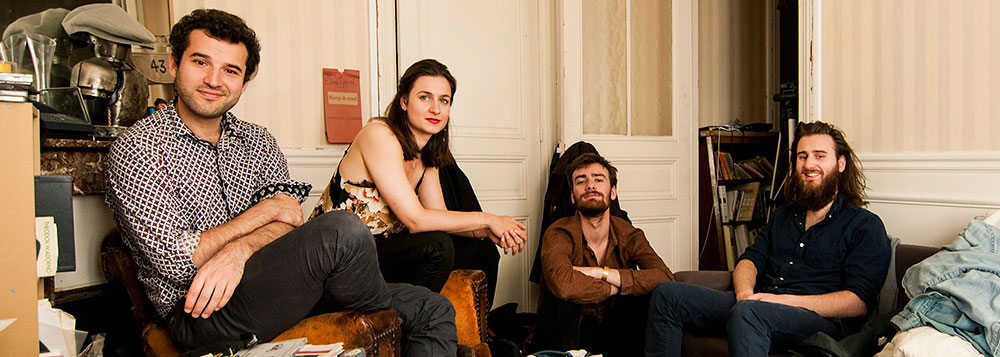
Since 2006, the Morgan and Boston Early Music Festival have partnered to present outstanding early music concerts in Gilder Lehrman Hall. These include renowned instrumental and vocal ensembles plus celebrated semi-staged productions of lesser-known Baroque operas. Although Nevermind (Anna Besson, flute, Louis Creac’h, violin, Robin Pharo, viola da gamba, Jean Rondeau, harpsichord) is not able to perform in our auditorium this year, we are delighted to launch a series of streaming concert broadcasts, beginning on Friday, October 16, 8 PM (EST).
Visit the concert listing for information about joining the Livestream and learn more about the The Art of Fugue in the Program notes below.
Program Notes
By Gabe Alfieri
If Bach’s aim in writing The Art of Fugue was to explore the limits of a compositional technique, or encompass and systematically record his life’s achievement as a contrapuntist, or something along those lines, then it seems not unfitting that he should have left the choice of instruments unspecified. Perhaps he wasn’t thinking of performance at all, but in more abstract or universal terms. Or perhaps he knew that, by leaving the choice and combination of instruments open, his work would reveal new aspects of itself each time it was heard in a different combination of sounds, ad infinitum.
Fugue involves a main theme, called the subject, presented among the various parts in such a way that it becomes familiar before it is then developed into a hopefully interesting and affecting musical work. The whole of The Art of Fugue uses a single subject for a series of eighteen explorations of fugal and canonic techniques, exploited systematically yet virtuosically as only Bach could do. In the first four sections—he called them “contrapunctus” or “counterpoint,” suggesting both an abstract technical element and a nod to stile antico—the subject is presented first in its basic form (#1), then inverted (the intervals moving in the opposite directions from the original, #4). While letting the ear follow the subject and its derivatives through the weave of counterpoint, and relishing both the beauty and ingenuity of its ever-shifting musical context, note the arresting silences in Contrapunctus 1 just before the final statement, and the expansion of the musical ideas in Contrapunctus 4.
Georg Philipp Telemann’s Twenty Little Fugues, TWV 30 (1731), were pedagogical in intent and their connection to an earlier set of chorale harmonization as well as their incorporation of ancient church modes suggest liturgical use. They harken back to the older “learned” polyphony, while incorporating the lighter textures of the new galant style. The choice here to perform the brief Fuga 14 on four different instruments, each with its distinctive timbre, allows the listener to identify each fugal voice by instrument while simultaneously producing a sort of sonic swirl of all four.
One of the most prolific and successful European art music composers of all time, Telemann is said to have been especially attracted to French musical styles, so when the opportunity came to visit, and eventually live and work for a time, in Paris, both the artist and the shrewd businessperson in him no doubt leapt at the opportunity. The New Paris Quartets are a set of six chamber works for flute, violin, viola da gamba, and continuo (keyboard) originally published in Paris in 1738 in conjunction with his Paris sojourn (though not originally given the designation of place, which was added in the twentieth century). These works are said to culminate the “Sonate auf Concertenart” form, in which features of the concerto are incorporated into the sonata, a hybrid Telemann himself may have originated. (He frequently made a point of blurring the boundaries between instrumental genres such as the suite, the overture, the sonata, and the concerto.)
Quartet No. 4 opens with a triple-time Prelude divided into three clear sections, fast-slow-fast, not unlike a mini-overture in the Italian style. Note the alternation of the opening musical material with brief sections highlighting the different instruments, reminiscent of concerto ritornello technique. A slow middle section provides all-important contrast, complete with a cadenza-like moment just before the opening musical material returns. In the second movement, “Coulant” (flowing), changes of texture and instrument combinations provide variety, while triple meter suggests the measured elegance of a fashionable dance in the galant style. The third movement, “Gay,” is indeed gay and skipping, even gigue-like, while the fourth, “Vite,” takes ebullience to the limits of propriety, with contrasts of timbre and texture that feed the energy in an almost comic fashion. It is no surprise that the following movement should take us somewhere completely different, emotionally speaking: “Triste” is permeated with a staid sadness of gentle sobs and quiet dissonance created through suspensions and trills. The work ends with an overt nod to the dance suite, a stately French “Menuet.”
Marin Marias studied viol with the renowned virtuoso Sainte-Colombe and composition with Lully. From 1679, he was employed at the French court as ordinaire of the musique de la chambre du roi. His Suite No. 4 in B-flat major “for the King’s sleep” is, formally speaking, a fairly typical French Baroque suite, consisting of eight dances of varying character in between a more expansive opening Prelude and closing movement, here called “Plainte.” If the aim of this music was to help the King (Louis XIV) sleep, then the opening Prelude seems perfectly suited to its aim, with gently rocking inégal, ambling bass line, sweetly warbling melody, and rich, warm sonorities. Though the intervening dances might not have served this purpose quite so well—none are especially languorous—the eighth, a sarabande “La Marianne,” is even more restful than the opening, with less rhythmic movement, more sense of stasis and repose only occasionally intensified by sensuous dissonance. The suite ends in dreamland, so to speak, with the closing “Plainte”: if a complaint is being made here, it is without conviction. It is, however, made with beautiful music that shimmers as it gently sinks into slumber.
